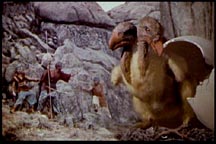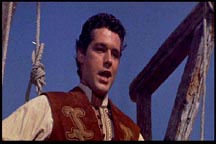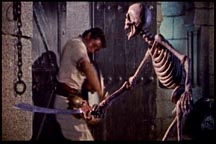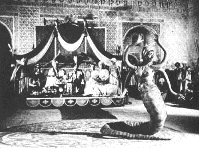
|
|
|
Come with the wind April 12, 2002 Along with "Aladdin" and "Hadji Baba", "Sinbad the Sailor" is most probably among the most popular and adventurous hero of "Thousand and One Night" tales. Sinbad was also to be a subject of three major feature films considered as motion picture classics. However the first film "The Seventh Voyage of Simbad" was to launch Ray Harryhausen as a master pioneer in the field of special effects.
Adrift at sea with a nervous crew, legendary Captain Sinbad (Kerwin Mathews) steers his ship to the island of Colossa to search for food and water. On the island, the crew encounters a giant cyclops who is pursuing the magician, Sokurah (Torin Thatcher) carrying a magic lamp. Coming in aid of Sokurah, Sinbad rescues him in time for the magician to use a magic lamp to build a barrier between the Cyclops and fleeing sailors. Once back on the ship Sinbad heads towards Baghdad with the Princess, "Parisa of Chandra" where wedding plans are to be made for them. His wedding will unite two kingdoms who once struggled at war.
At a feast where the rulers of the two kingdoms meet to solidify their Kingdoms, Sokurah is called upon for entertainment. Sokurah desires to return to his island, the home of the cyclops, but Baghdad's Caliph will not sanction a ship or crew based on Sinbad's warnings. Sokurah plans to marvel the Sultan into granting his request. Enlisting the assistance of the Princess Parisa's maiden in mating, Sardi, Sokurah transforms her into a stunning serpent woman. The transformation is not enough to persuade the Caliph to grant Sokurah's voyage so the evil magician sends a prophecy of doom to them and declares war between the two kingdoms.
It is a prophecy that Sokurah plans to ensure himself by transforming the Princess into a tiny figure of a few inches. The Sultan of Chandra, the Princess' father, vows the destruction of Baghdad as Sinbad hurries to find Sokurah. Sokurah guarantees that he can restore the princess but only by returning to his island and obtaining the egg shell of the Roc, a giant two-headed bird. Enlisting the help of his bravest crew and recruiting others from the Caliphs prisons, Sinbad sets sail for Colossa.
En route to the island, the prisoners have decided to mutiny rather than face
the dangers of Colossa. The ship is taken, and Sinbad, Harufa (Sinbad's first mate)
and Sokurah are taken prisoner. Sokurah forewarned impending doom unless they are
freed. His prophecy is laughed at until a storm breaks. The ship heads for an island
inhabited by screaming demons who lure the ships' crews to madness as their ships
crash against the ragged shoreline.Sinbad, Harufa and Sokura have saved themselves
from the maddening screams by sealing their ears with wax and rags. The ships prisoners
are freed as the leader of the mutineers falls to his deaths from the ships crows
nest.
The Cyclops captures the group and places them in a wooden prison while taking
Harufa and attacking him to a giant spit, planning to have Harufa for supper. Sokurah
arrives, but not to rescue Sinbad. He has come only for the magic lamp. Sinbad is
forced to use the Princess who, because of her tiny stature can free them.
Sinbad tells the Princess of the magic lamp and the egg shell. The Princess decides
to go inside the lamp where she discovers the boy genie inside. The boy genie (Richard
Eyer) informs her that his name is Baroni and tells her the words that summon him:
Schneer saw the drawings and became interested in the project and began shopping around for studio backing. He would later comment that 7TH VOYAGE was an "in-between cost" movie, in that its budget would not be low enough to take a gamble on and the possibility that it was too costly to return a profit. Using Ray's sketches, Charles Schneer and Harryhausen sold the distribution rights to Columbia Pictures.
It was decided that the sets would be too costly to build so they went to Spain seeking
locations for the film. They found two perfect ones in the Alhambra in Madrid and
the Cages Of Artha in Majorca. They also discovered, while on location, that the
throne room in the Alhambra was the place where Ferdinand and Queen Isabella gave
Columbus the money that financed Columbus' discovery of America.
A Spanish film crew and supporting actors were hired for the project. This move
to Spain proved to serve another advantage for Schneer. He managed to persuade a
harbor master to allow them to use a re-creation of Columbus' ship, the Santa Maria
as Sinbad's ship. This ship was used for several shots, most made during a time when
Kerwin Mathews (Sinbad) became dreadfully ill. While shooting some of the storm shots in the harbor, the Barcelona fire department was brought in to spray the ship with water attempting to recreate the wailing siren sequence. The shots Schneer wanted Mathews for included being sprayed by the fire department. Since Spain doesn't run into the same problems with environmental groups, the water that was pumped from the harbor was not the cleanest.
In spite of illness, Kerwin Mathews delivers a fine Sinbad. Mathews was a contract player for Columbia and he was among several young actors considered, including Glenn Ford. Watching Mathews interact with Ray's creatures is almost as amazing as the creatures themselves. It must be remembered that the actors have nothing to go on but their own imagination and a few reference points. Of all the actors in the Harryhausen films, Mathews manages to capture this quality the best, seeming to make eye contact with the creatures that aren't there for him.
This is especially true when he interacts with the Princess when she is in her
miniature state. His eyes always seem to follow her. Upon original consideration, the CYCLOPS was to be more human like in appearance but Ray decided to create a more animal-like lower half that could never be dismissed as an actor in a costume. There were also to be two different Cyclops who battle one another in the original draft but this was tossed out by budget limitations. Two different Cyclops do appear in the film, careful observers will note that the first Cyclops has one horn while the second has a smaller horn behind the larger one.
The Cyclops is the first creature to make an appearance and he does so in the
first few minutes of the film. As Sinbad and crew arrive on the island of Colossa,
The Cyclops is pursuing Sokurah. As this action unfolds around us, the Cyclops is
part of the action, moving in and around the actors. This unique blending of stop-motion
animation and live-action required a new name for several reasons. Harryhausen once
stated that he coined the term "dynamation" because the critics and reviews
constantly referred to their films as animated films and that people would confuse
them as cartoons. He had hoped the term "dynamation" would clarify some
of the confusion
Ray needed a massive miniature set for the interior shots of the cave. It was very critical that this set would match the live sets and that the lighting of the miniature sets equaled the lighting on the live sets. This set included an extremely detailed exterior of Sokurah's castle which was hidden deep inside the cave. Much of the action in the last third of the film takes place in a near perfect blending of the miniature set and the live action set. The interior of the cave was also home to one of the screens most fearsome dragons.
To call the dragon in THE 7TH VOYAGE OF SINBAD amazing is an understatement. It
is simply beautiful in its detail and sheer size. From the moment the dragon appears,
Ray manages to give this creature an awesome feeling of being real. It pulls on its
chains struggling for freedom and breathes heavily. Each heaving sigh is created
by the inclusion of an air bag inside the miniature model. Ray also made the dragon
a colorful creature with its red tinted horned back and its bright green colors.
The sequence remains the highest animated experience of the whole film. It is this sequence that we quickly remember during the discussions of the film. It is so meticulously planned and executed that it leaves us with that awe-inspired feeling of "how did yiu do that!" And in those of use who were lucky enough to see this film as a very young child, the fear that the damn thing just might be real. The Dragon and the Cyclops could never get in our bedrooms but that hideous skeleton
with the eternally evil smile could drop out of the closet and there would be hell
to pay. After all, how do you kill something that is already dead? This sequence
was deemed so disarming by the British Censor board that it was cut from the print
altogether. It was later restored but it was years later. its hard to imagine watching
this film without the Skeleton duel sequence. During this screening, Herrmann sat quietly through the entire film when it was
finished simply stated that he thought he could do something for the picture. What
he did was create the most impacting score of any fantasy film since Max Steiner
and KING KONG. The score for this film is the perfect pairing of the two mediums
and it is certainly a must have in any soundtrack collection. The owners of the Roxy had decided that they would screen one more film after
John Ford's, THE LAST HURRAH, and SINBAD was their picture. It proved to be so financially
successful for them that the theater remained open for another 2 years. From this
point on the Harryhausen/Schneer collaborations would reflect the episodic appearance
and multi-creature cast that helped make Sinbad the success it was. Edited by Shiva Pakdel
|
|
 |
Web design by BTC Consultants
Internet server: Global Publishing Group








































